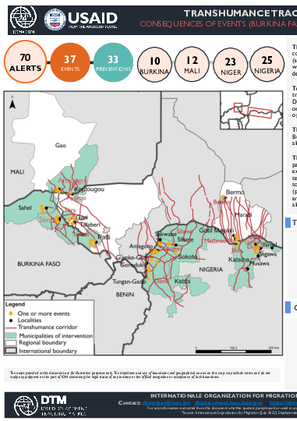-
Countries
-
Data and Analysis
-
Special Focus
-
Crisis Responses
To better understand transhumant movement trends and the impact of vulnerabilities on transhumant communities, IOM has deployed the Transhumance Tracking Tool (TTT), through its Displacement Tracking Matrix (DTM), with the Bilital Maroobe Network (RBM) and its pastoralist organization branches to monitor transhumance in cross-border areas in countries where RBM operates.
The TTT provides an understanding of the dynamics of cross-border transhumance between Burkina Faso, Niger, Nigeria and Mali by combining three components: mapping, counting and alerting.
The purpose of the alert system is to identify events related to the use of natural resources, agro-pastoral practices, and disasters in the cross-border area of different countries, to understand the existing conflict resolution methods, and to inform competent authorities in order to reduce tensions in the municipalities of intervention. This system makes it possible to identify alerts related to a conflict event (event alert) or to a massive, early, late or unexpected movement of livestock (prevention alert) that could lead to conflict. These alerts, once transmitted to the various actors, are used for conflict prevention or actions towards resolutions. This report presents data from the alert tool for the months of May through June 2022.
Statut des sites spontanés ouverts à partir du 24 avril à cause de violences dans la zone métropolitaine de Port-au-Prince, au 1 août 2022.

Contact
DTM Uganda, dtmuganda@iom.int
Language
English
Location
Uganda
Period Covered
Jul 01 2022
Jul 31 2022
Activity
- Mobility Tracking
July was characterized by floods and Mudslide in the eastern region (Elgon sub region) which were triggered by heavy and extended rains on the 30th and 31st of July 2022. Transport related accidents were also reported in Wakiso district. o A total of 12,202 individuals were affected, representing 2,692 households. 6,630 individuals from 1,105 households were internally displaced by the disasters. o Adults (19-64) were the most affected population group (49%), followed by children under 18 (34%) and the elderly above 64 (17%). o The most pressing needs are health, shelter, education and non food items. o So far in 2022, 80,568 individuals have been affected by disasters, representing 15,800 households. A total of 11,945 individuals representing 3,668 households have been internally displaced. o The Kisoro refugee status stand at 41,120 refugees received in Uganda and 17,874 at the holding and transit center

Contact
DTM Colombia, DTMColombia@iom.int
Language
Spanish
Location
Colombia
Period Covered
Jul 01 2022
Jul 28 2022
Activity
- Flow Monitoring
El 87% de los nacionales venezolanos entrevistados(as) indican que proceden de la República Bolivariana de Venezuela, destacándose que el 15% provienen del Distrito Capital y Zulia cada uno y el 9% de Carabobo. En una proporción menor provienen de otros países como: Perú (6%), Ecuador (6%) y Chile (2%)

Contact
DTMAfghanistan@iom.int
Language
English
Location
Afghanistan
Period Covered
Mar 01 2022
Apr 30 2022
Activity
- Mobility Tracking
- Site Assessment
- Baseline Assessment
DTM has been conducting the Baseline Mobility Assessment in Afghanistan since 2016 to track mobility, provide information on population estimates, locations and geographic distribution of displaced and returnee populations, reasons for displacement, places of origin and periods of displacement. Vulnerabilities and multi-sectoral needs are covered in the Emergency Community- Based Needs Assessment (eCBNA) at the end of the report. Data is collected at the settlement level, through focus group discussions with community focal points and direct observations.
This province highlight delves into the key findings in Nangarhar province using the latest results from Round 15 of the BMA and eCBNA (conducted in March and April 2022), focusing on the 2021-to-2022 period. The full report can be found here: Baseline Mobility and Emergency Community-Based Needs Assessment Report (Round 15, March—April 2022)
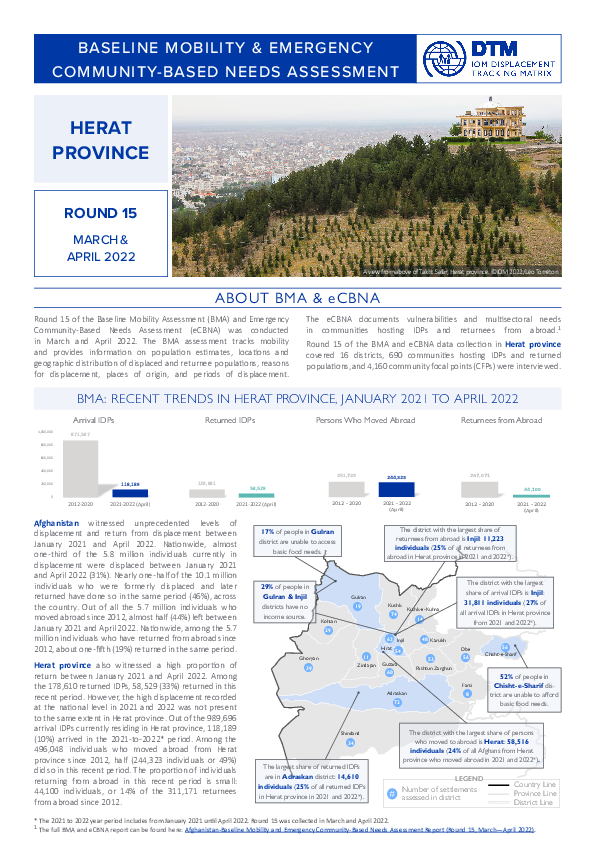
Contact
DTMAfghanistan@iom.int
Language
English
Location
Afghanistan
Period Covered
Mar 01 2022
Apr 30 2022
Activity
- Mobility Tracking
- Site Assessment
- Baseline Assessment
DTM has been conducting the Baseline Mobility Assessment in Afghanistan since 2016 to track mobility, provide information on population estimates, locations and geographic distribution of displaced and returnee populations, reasons for displacement, places of origin and periods of displacement. Vulnerabilities and multi-sectoral needs are covered in the Emergency Community- Based Needs Assessment (eCBNA) at the end of the report. Data is collected at the settlement level, through focus group discussions with community focal points and direct observations.
This province highlight delves into the key findings in Herat province using the latest results from Round 15 of the BMA and eCBNA (conducted in March and April 2022), focusing on the 2021-to-2022 period. The full report can be found here: Baseline Mobility and Emergency Community-Based Needs Assessment Report (Round 15, March—April 2022)
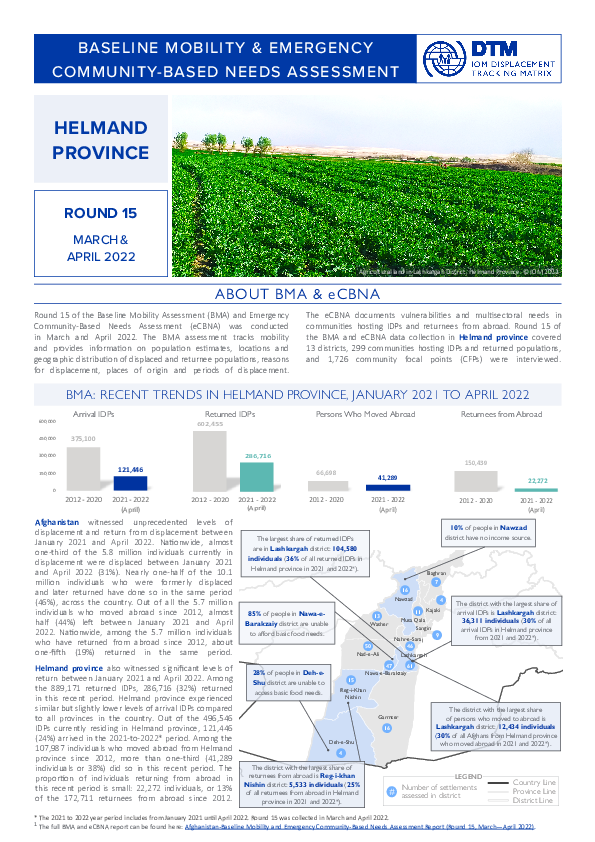
Contact
DTMAfghanistan@iom.int
Language
English
Location
Afghanistan
Period Covered
Mar 01 2022
Apr 30 2022
Activity
- Mobility Tracking
- Site Assessment
- Baseline Assessment
DTM has been conducting the Baseline Mobility Assessment in Afghanistan since 2016 to track mobility, provide information on population estimates, locations and geographic distribution of displaced and returnee populations, reasons for displacement, places of origin and periods of displacement. Vulnerabilities and multi-sectoral needs are covered in the Emergency Community- Based Needs Assessment (eCBNA) at the end of the report. Data is collected at the settlement level, through focus group discussions with community focal points and direct observations.
This province highlight delves into the key findings in Helmand province using the latest results from Round 15 of the BMA and eCBNA (conducted in March and April 2022), focusing on the 2021-to-2022 period. The full report can be found here: Baseline Mobility and Emergency Community-Based Needs Assessment Report (Round 15, March—April 2022)
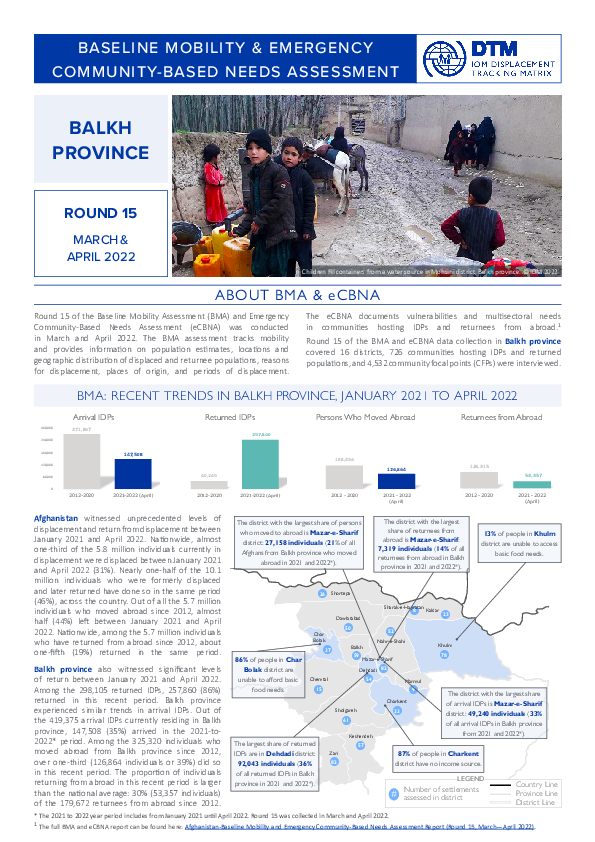
Contact
DTMAfghanistan@iom.int
Language
English
Location
Afghanistan
Period Covered
Mar 01 2022
Apr 30 2022
Activity
- Mobility Tracking
- Site Assessment
- Baseline Assessment
DTM has been conducting the Baseline Mobility Assessment in Afghanistan since 2016 to track mobility, provide information on population estimates, locations and geographic distribution of displaced and returnee populations, reasons for displacement, places of origin and periods of displacement. Vulnerabilities and multi-sectoral needs are covered in the Emergency Community- Based Needs Assessment (eCBNA) at the end of the report. Data is collected at the settlement level, through focus group discussions with community focal points and direct observations.
This province highlight delves into the key findings in Balkh province using the latest results from Round 15 of the BMA and eCBNA (conducted in March and April 2022), focusing on the 2021-to-2022 period. The full report can be found here: Baseline Mobility and Emergency Community-Based Needs Assessment Report (Round 15, March—April 2022)
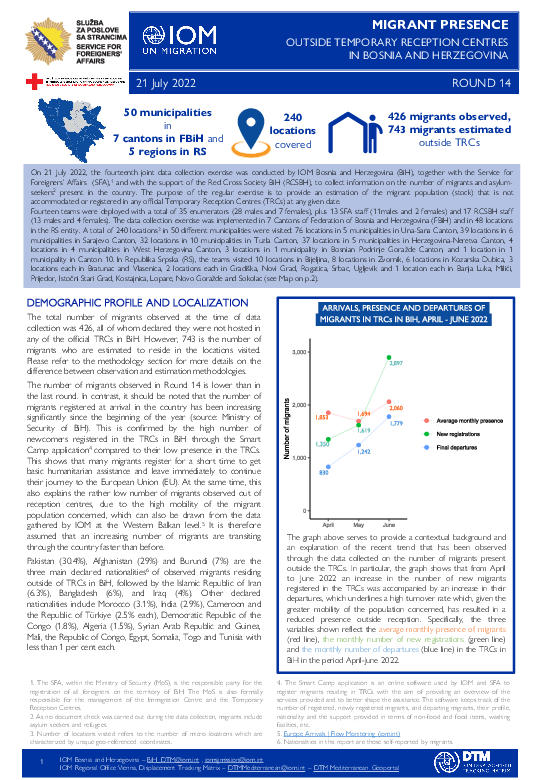
Contact
DTM Europe, DTMMediterranean@iom.int
Language
English
Location
Bosnia & Herzegovina
Snapshot Date
Jul 21 2022
Activity
- Migrants presence
- Mobility Tracking
On 21 July 2022, the fourteenth joint data collection exercise was conducted by IOM Bosnia and Herzegovina (BiH), together with the Service for Foreigners’ Affairs (SFA), and with the support of the Red Cross Society BiH (RCSBH), to collect information on the number of migrants and asylum-seekers present in the country. The purpose of the regular exercise is to provide an estimation of the migrant population (stock) that is not accommodated or registered in any official Temporary Reception Centres (TRCs) at any given date.
Fourteen teams were deployed with a total of 35 enumerators (28 males and 7 females), plus 13 SFA staff (11males and 2 females) and 17 RCSBH staff (13 males and 4 females). The data collection exercise was implemented in 7 Cantons of Federation of Bosnia and Herzegovina (FBiH) and in 48 locations in the RS entity. A total of 240 locations3 in 50 different municipalities were visited: 76 locations in 5 municipalities in Una-Sana Canton, 39 locations in 6 municipalities in Sarajevo Canton, 32 locations in 10 municipalities in Tuzla Canton, 37 locations in 5 municipalities in Herzegovina-Neretva Canton, 4 locations in 4 municipalities in West Herzegovina Canton, 3 locations in 1 municipality in Bosnian Podrinje Goražde Canton, and 1 location in 1 municipality in Canton 10. In Republika Srpska (RS), the teams visited 10 locations in Bijeljina, 8 locations in Zvornik, 6 locations in Kozarska Dubica, 3 locations each in Bratunac and Vlasenica, 2 locations each in Gradiška, Novi Grad, Rogatica, Srbac, Ugljevik and 1 location each in Banja Luka, Milići, Prijedor, Istočni Stari Grad, Kostajnica, Lopare, Novo Goražde and Sokolac (see Map on p.2).

Contact
DTM Europe, DTMMediterranean@iom.int
Language
Bosnian, Croatian, Serbian
Location
Bosnia & Herzegovina
Snapshot Date
Jul 21 2022
Activity
- Migrants presence
- Mobility Tracking
21.7.2022. IOM u Bosni i Hercegovini (BiH) je u saradnji sa Službom za poslove sa strancima(SPS) i uz podršku Crvenog križa/krsta BiH (CKBiH) proveo četrnaestu zajedničku vježbu kako bi se prikupile informacije o broju migranata i tražilaca azila koji se trenutno nalaze u državi. Svrha ove redovne vježbe je da se pruži okvirni broj migrantske populacije koja nije smještena ili registrovana ni u jednom od privremenih prihvatnih centara (PPC) u bilo kojem trenutku.
Raspoređeno je ukupno četrnaest timova sačinjenih od 35 popisivača (28 muškaraca, 7 žena), uz dodatnih 13 inspektora SPS-a (11 muškaraca, 2 žene) i 17 uposlenika CKBiH (13 muškaraca, 4 žene). Vježba prikupljanja podataka je provedena u 7 kantona Federacije Bosne i Hercegovine (FBiH) i 48 lokacija unutar Republike Srpske (RS). Posjećeno je ukupno 240 lokacija³ u 50 različitih općina. Timovi su u FBiH posjetili 76 lokacija u 5 općina Unsko-sanskog kantona, 39 lokacija u 6 općina Kantona Sarajevo, 32 lokacije u 10 općina Tuzlanskog kantona, 37 lokacija u 5 općina Hercegovačko-neretvanskog kantona, 4 lokacije u 4 općine Zapadno-hercegovačkog kantona, 3 lokacije u 1 općini u Bosansko-podrinjskom kantonu Goražde i 1 lokaciju u 1 općini u Kantonu 10. Timovi su u RS-u posjetili 10 lokacija u Bijeljini, 8 lokacija u Zvorniku, 6 lokacija u Kozarskoj Dubici, po 3 lokacije u Bratuncu i Vlasenici, po 2 lokacije u Gradišci, Novom Gradu, Rogatici, Srpcu, Ugljeviku i po 1 lokaciju u Banjoj Luci, Milićima, Prijedoru, Istočnom Starom Gradu, Kostajnici, Loparama, Novom Goraždu i Sokocu (vidi Mapu na str.2).
